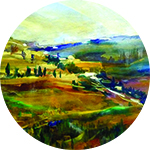Walls and Doors

Replace fractures and friction with friendship, healing, and hope

IN Teves, the memory of the destruction and suffering wreaked by our entrapment in galus comes to the fore. Zecharyah Hanavi (8:19) talks about the fast of the 10th of this month as being something observed forever by “Beis Yehudah.” Of the Rabbinic fasts, this is in a way the most stringent. Both the Beis Yosef and the Avudraham posit that if the 10th of Teves were to fall out on Shabbos, we would nevertheless fast, just as we do when Yom Kippur coincides with it.
We observe a fast on the tenth of the month, but it commemorates three tragedies that occurred in Teves: the death of Ezra Hasofer, the Targum Shivim (the creation of the Septuagint, when the Torah was forcibly translated into Greek), and the beginning of Babylonian and Roman sieges of Yerushalayim. In the Selichos of the day we say, “I will recall the calamity that encountered me, on three days in this month He hit me.”
In his sefer Noam Siach, Rav Shneur Kotler elaborates on the shared message of these events. Ezra Hasofer died when he was still in the process of giving over Torah shebe’al peh. He was taken (by Hashem’s plan, of course) before finishing what he’d set out to accomplish. This caused many years of toil and confusion and created a huge pegam — I’d like to translate that as “deficit” — in the Torah.
Translating the Torah into Greek also created a deficit in the Torah. I recall one of the baalei mussar writing that it was like taking the Torah and removing its clothing in front of the world. The ramifications of this are still felt. By making the Torah accessible to everyone, not just those who spoke Lashon Kodesh and were sensitive to its holiness, the Torah became vulnerable to contortion and criticism. It also enabled non-Jews to torture and antagonize the Jewish People, which they justified by distorting the Torah to support their hateful intentions.
The siege of Yerushalayim is the pinnacle of all that pain. This was the first step toward the demise of the presence of the Shechinah in our world, and the beginning of the battles that would ultimately result in the burning of our Mikdash.
Cracks and Doorways
A defining characteristic of a wall, explains Rav Kotler, is that it stands upright and encloses something, making that space impenetrable. The only way to enter or exist in that space is through a door. The root of the Hebrew word, deles, door, is dal, meaning poor, lacking. A door, fashioned to swing open and shut, reflects vulnerability, a lack of security, and is pervious to harmful encroachment.
Avraham Avinu proclaimed. “I am a wall!” The pasuk continues, “And my bosom is like towers” (Shir Hashirim 8:10). Midrash Rabbah there elaborates and explains that Avraham Avinu was telling the Ribbono shel Olam, “I will establish my fine deeds like a wall, and I will establish groups of tzaddikim like me in your world.”
Establishing groups of tzaddikim, explains Rav Kotler, is the prescription necessary for every individual and all factions of Klal Yisrael to survive galus midor l’dor. This method of establishing groups of tzaddikim before the arrival of the masses began when Yaakov Avinu sent Yehudah ahead to Goshen. The mesorah Yehudah received from learning in Yeshivas Shem V’Ever would help him succeed in that endeavor.
At the time of Ezra, Klal Yisrael was in a fragmented state. The lure of their beautiful homes, business success, and social milieu in Persian culture meant that the majority of the Jews at the time didn’t return to Eretz Yisrael. The Rambam says that the situation in Eretz Yisrael was so dire, the Jews living there couldn’t afford the terumos and maasros they were required to contribute. That reflected the poor state of the Mikdash and the morale of the Kohanim serving there.
Since the Shechinah in the Beis HaMikdash is one and the same as the Shechinah in Eretz Yisrael, it followed that they both were lost in wake of the Beis Hamikdash’s state of disrepair. The one remaining transcendent force is the Shechinah inside every Jew.
Inner Wholeness
While Yaakov prevailed in the battle against saro shel Eisav, the angel managed to injure him. This left Yaakov with a slight limp. No limb was missing, but something had been dislocated. For Klal Yisrael, this manifests itself as fragmentation in our quest for balance between the forces of the holy and mundane, serious and fun, relaxed and agitated. The first step in our avodah to bring all the broken parts together is to build ourselves up so that the “cracks” in our life don’t become doorways.
I recall a video I saw of Rav Avrohom Pam ztz”l speaking on behalf of his beloved Shuvu school network. His face, even in his most passionate moments, still reflected the inner peace he radiated throughout his life.
Such is the nature of those who are tzaddik v’yashar. Each facet of their life reflects their inner strength and joy. They have worked toward shleimus, wholeness; their self is no longer fragmented.
In a famous letter responding to a student who claimed that his leaving the yeshivah for the work force made him feel like he was leading a “double life,” Rav Yitzchok Hutner ztz”l introduced the concept of a Jew living a “broad life.”
The myriad roles we play fluctuate. Some of us are daughters, wives, mothers, sisters, grandmothers, teachers, students, bosses, employees. No matter our family status, we’re all gifted with the role of being a friend. The beauty of all our relationships is the G-dliness we invest in each one.
I’m respecting the humble nature of the rabbi in the story I’m about to describe by not identifying him, but I can assure I heard this story firsthand from the protagonist. A gentleman took his young son to meet his venerated rebbi.
Unabashedly, the young boy asked, “Rebbi, what do you think about when you aren’t learning Torah?”
Without missing a beat, the rebbi responded, “What does Hashem want from me right now?”
Shivisi Hashem l’negdi tamid should be the focal point of each hour, of each minute of our lives. The Torah passed on by Ezra, which was sullied by the Greeks, must remain our guidebook for ever.
Let’s all create a wall of friendship and love for one another and the Ribbono shel Olam.
Meheirah, Hashem, tivneh chomos Yerushalayim
Rebbetzin Aviva Feiner is the rebbetzin of Far Rockaway’s Congregation Kneseth Israel (The White Shul) as well as a mechaneches in TAG and a visiting lecturer at Stern College.
(Originally featured in Family First, Issue 824)
Oops! We could not locate your form.







